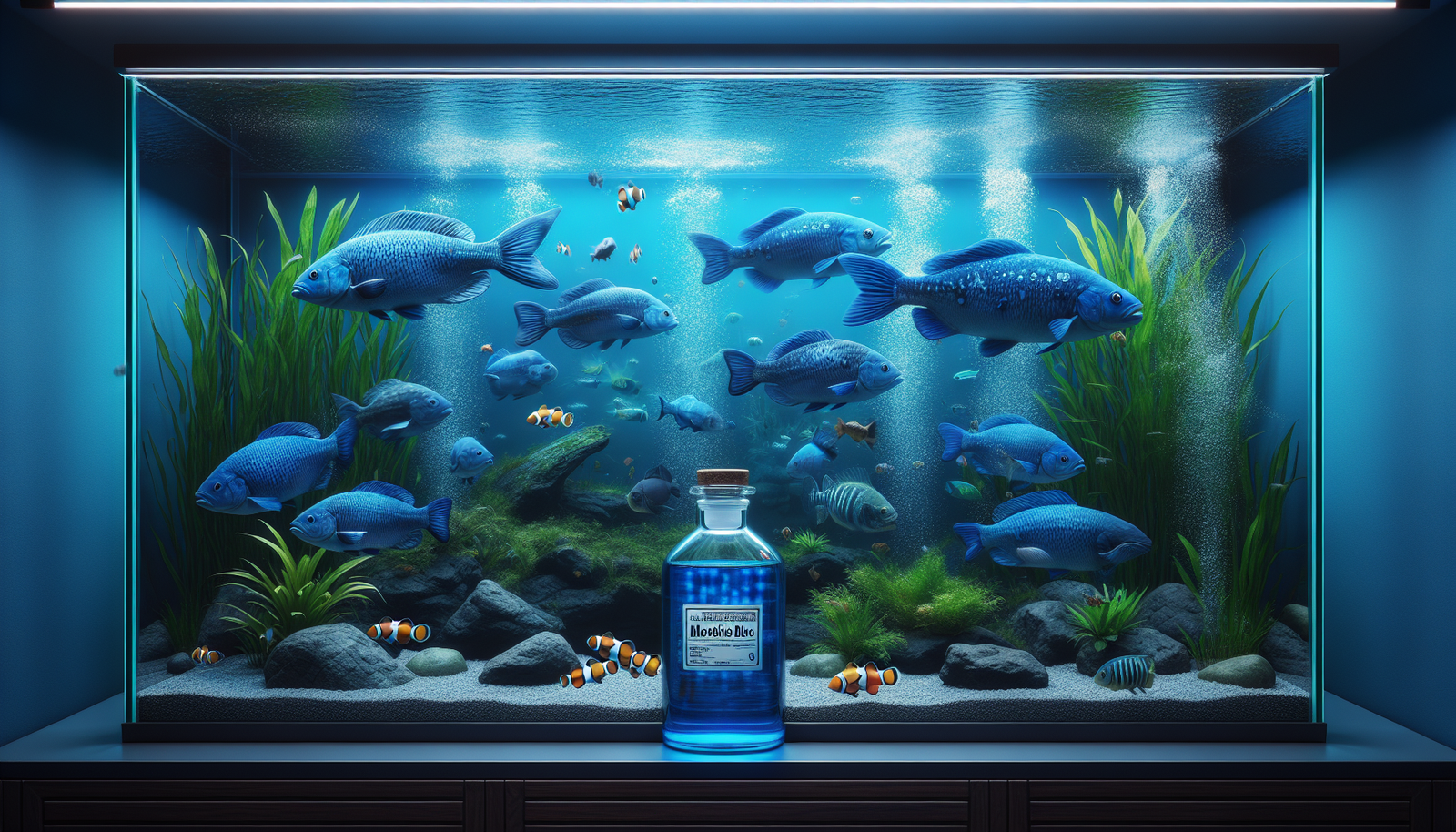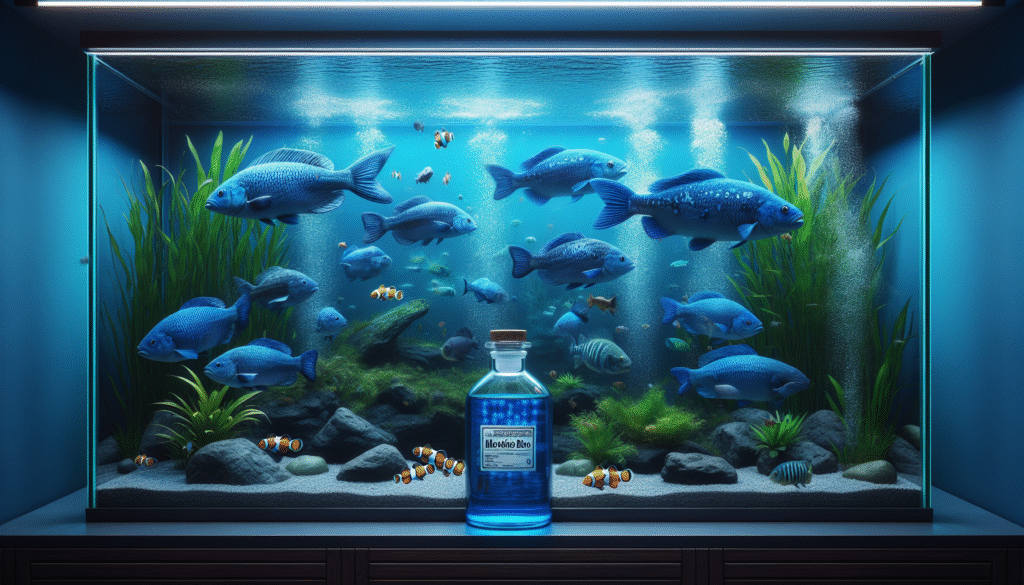
Have you ever considered the myriad ways in which the chemistry of your aquarium affects the health of its inhabitants? When it comes to maintaining a thriving aquatic environment, understanding the role of various substances is crucial. One such substance, Methylene Blue, has garnered attention not only for its historical significance in medicine but also for its implications in aquaculture. Your choices regarding additives, medications, and treatments can dictate the well-being of your fish, and Methylene Blue stands out in both its applications and effects.
What is Methylene Blue?
Methylene Blue is a synthetic dye that was first synthesized in the 19th century. Originally used as a textile dye, it has found applications as an antiseptic and a treatment for methemoglobinemia—a condition where hemoglobin is unable to effectively deliver oxygen to the body. In the context of aquariums, Methylene Blue serves both therapeutic and preventive roles, particularly in regard to fish health.
Chemical Properties
Understanding the chemical properties of Methylene Blue can help you appreciate its functionality. This compound carries the chemical formula C16H18ClN3S and is known for its distinctive blue color. Its solubility in water allows it to easily diffuse throughout an aquatic environment, making it particularly effective for treating illnesses in fish.
Mechanism of Action
Methylene Blue works in a multifaceted manner. Its primary mechanism involves acting as a redox agent, which can improve oxygen transport in the blood of fish. The dye can also inhibit the growth of certain pathogens, potentially reducing the prevalence of infections. Its ability to intercalate into the DNA of bacteria can impede their replication, thereby protecting your fish from harmful outbreaks.
Benefits of Methylene Blue in Aquariums
Utilizing Methylene Blue can bring multiple benefits to your aquarium ecosystem. However, it is pivotal to understand when and how to integrate this substance for optimal results.
Treatment of Fish Diseases
Methylene Blue is particularly effective against various fungal and protozoan infections. This includes diseases such as:
- Ichthyophthirius multifiliis (Ich): A common parasitic infection, often referred to as “ich.”
- Fungal infections: Affecting wounds or lesions on the fish.
- Costia: A pathogen that can lead to skin diseases in fish.
In these situations, Methylene Blue acts swiftly to alleviate symptoms and safeguard the health of your aquatic pets.
Prevention of Infections
In addition to treating existing conditions, Methylene Blue can function as a preventive measure. Soaking fish eggs or acclimating new fish in a diluted solution may reduce the risk of potential diseases. This preventative approach can be particularly useful in community tanks where the risk of infection may be heightened due to close proximity of various fish species.
Improvement of Stress Responses
Stress is an ever-present factor in the lives of your aquarium fish, whether due to environmental changes, tank mates, or transport. Methylene Blue has been noted to reduce stress in fish by improving their oxygen transport capacity and stabilizing their physiological responses. This enhancement can lead to reduced mortality rates and a greater overall sense of well-being among your fish.

How to Use Methylene Blue
Administering Methylene Blue in your aquarium requires a mindful approach to ensure its efficacy while minimizing potential side effects. Understanding the proper dosages and methods will enhance your success.
Dosage Recommendations
When using Methylene Blue, dosing is key. The concentration that is commonly recommended for treating fish diseases is around 1-2 mg per liter of aquarium water. For preventive measures, a lower concentration, approximately 0.5 mg per liter, may suffice. Always consider the specific needs of your fish species, as some may exhibit sensitivity to dye concentrations.
| Purpose | Dosage |
|---|---|
| Treatment of diseases | 1-2 mg/L |
| Preventative measure | 0.5 mg/L |
Application Techniques
You can introduce Methylene Blue into your aquarium in various ways, often depending on the situation and the tank’s inhabitants. Below are methods you might consider:
-
Direct Application: For treating a specific ailment, measure the required dosage and add it directly to the tank while ensuring that water movement distributes it evenly.
-
Soaking Fish Eggs: For breeding scenarios, prepare a separate container with tank water and the appropriate dosage of Methylene Blue. Soak the eggs for a brief period to prevent fungal growth.
-
Quarantine Tanks: If introducing new fish, use a quarantine tank with a diluted solution of Methylene Blue. This practice allows for monitoring any potential health issues before introducing the new fish to your main tank.
Side Effects of Methylene Blue
While Methylene Blue offers various benefits, it is of utmost importance to be aware of potential side effects that can occur when using it in your aquarium.
Toxicity to Fish
Certain species are particularly sensitive to Methylene Blue. Fish like catfish and some tetras might experience adverse reactions, including increased stress or symptoms of toxicity. Care should be taken to monitor their behavior closely following introduction.
Impact on Biological Filtration
Methylene Blue can negatively affect the beneficial bacteria in your aquarium’s filtration system. These bacteria are crucial for maintaining a balanced nitrogen cycle. It is advisable to either temporarily remove your biological filter during treatment or use a product that explicitly states it does not harm beneficial bacteria.
Water Quality Alterations
Utilizing Methylene Blue will change the color of your aquarium water. While this is an expected outcome, it’s essential to keep an eye on other water parameters, such as pH, ammonia, and nitrites. Regular testing ensures your tank remains healthy and stable.

Alternatives to Methylene Blue
There are alternatives to Methylene Blue that also serve to maintain aquarium health. Each option has its unique benefits and drawbacks.
Herbal Remedies
Plants such as garlic and certain extracts have been shown to bolster fish immune systems and reduce susceptibility to disease. These natural options could provide a gentler alternative to synthetic dyes.
Other Medications
Antiparasitic and antifungal medications exist that can serve similar purposes to Methylene Blue. While these options may offer a more targeted approach to specific health issues, they often come with their own set of precautions and potential side effects.
| Treatment Type | Pros | Cons |
|---|---|---|
| Herbal Remedies | Natural, less harsh | Effectiveness may vary |
| Antiparasitic Medications | Targeted treatment options | Potential side effects |
Best Practices for Aquarium Maintenance
Incorporating Methylene Blue into your aquarium regimen is just one aspect of maintaining a robust and healthy aquatic ecosystem. Adhering to best practices in aquarium management is crucial for long-term success.
Regular Water Testing
Frequent testing of your aquarium water is essential. Regularly measure parameters, including pH, ammonia, nitrites, and nitrates, to ensure the health of your fish. Having a quick and accessible testing kit allows you to react promptly to any imbalances.
Consistent Water Changes
Perform routine water changes to dilute toxins and replenish necessary minerals that fish require. The frequency and percentage of water replaced depend on your tank’s bio-load, but a general rule of thumb is to change 10-15% of the water weekly.
Feeding Practices
Offering a balanced diet tailored to your fish species not only prevents malnutrition but also decreases waste production. Overfeeding can lead to poor water quality, prompting the need for more treatments like Methylene Blue.
The Role of Education in Aquaculture
Understanding the intricacies of aquarium care is vital for any aquarium enthusiast. Research is not merely about discovering new treatments or medications but extending to the environmental and biological aspects of fish health.
Continuous Learning
As a passionate hobbyist, continually educating yourself about advancements in aquaculture can only enhance your skills. Consider following reputable forums, reading scientific articles, and attending workshops. Each source offers opportunities to expand your knowledge base, helping you make informed decisions regarding your aquarium.
Engaging with the Community
Participating in aquarist communities can prove invaluable. Discussions on platforms like Reddit, Facebook groups, or specialized forums allow you to share experiences and gain insights from other fish keepers. You may uncover best practices or solutions to common problems encountered in aquarium care.
Conclusion
Utilizing Methylene Blue in your aquarium can indeed be a game-changer, but awareness and caution are paramount. As you embark on your journey of aquatic care, consider the health and well-being of your fish, the implications of chemical treatments, and the necessity for structured maintenance practices.
Enriching your knowledge and remaining vigilant in your aquarium’s health will set the stage for a flourishing aquatic habitat. With diligence and the right tools, Methylene Blue can efficiently serve its purpose, contributing positively to the life of your aquatic companions. Remember, every fish thrives in a well-managed environment, and your commitment plays a pivotal role in achieving that aim.